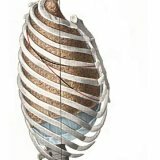Syndrome of anterior staircase

This syndrome has its name due to the stair muscles, and in particular the anterior staircase, the tension of which causes the appearance of this syndrome.
Features of the disease and its symptoms
The front staircase is located in the transverse processes of the cervical vertebrae, namely from the third to the sixth, and then the muscle is attached to the anterior edge of the first rib. The location of the middle staircase goes along the same path, but the attachment of it goes already to the posterior edge of the first rib. It is worth noting that the interstitial space, where the subclavian artery and the nervous brachial plexus passes exactly between the anterior muscle and the middle staircase. Further in the space between the anterior staircase, the sternum-hyoid and the thyroid-secretory muscles pass a very important subclavian vein and lymphatic vessels. All these descriptions of locations help to understand all possible anatomical relationships and in turn explain the entire mechanism of compression of the vascular-neural bundle, when hypertension of the anterior staircase arises.
Regarding the causes of the strain of the front staircase, it can be:
- compression or irritation of the roots of the spinal nerves, which come from both the lower and their upper cervical segments;
- process of squeezing the brachial plexus, which provides a process of innervation of the muscles of the shoulder girdle or muscles of the upper limbs and subclavian artery.
Due to the formation of the so-called "closed circle", a syndrome of the front staircase muscle is formed. In connection with the deterioration of blood circulation in the subclavian artery, there may be a worsening of the cerebral circulation, because it is the vertebral artery, which plays an important role in providing normal blood supply to the brain, from the subclavian artery suffering from this syndrome.
The main symptoms characteristic of this syndrome include complaints of the patient for certain pains in the hand and neck, the presence of a feeling of numbness in the distal parts of the upper limb. Increased pain due to movements of the cervical spine. Typical swelling and soreness in the palpation of the area, both over the subclavian fossa, and directly in it itself. There is a state of tension in the anterior staircase. In the process of pressing the projection area of stair muscles, there is a characteristic pain that can often radiate into the hand.
If you fix the neck and shoulder girdle, you can see the rise of the ribs I-II, this process increases the vertical size of the chest. As a consequence, when the I edge is raised, the inter-oestrus space decreases, which provokes squeezing of the neurovascular bundle, which goes to the upper limb. Let's notice, that at performance of every possible movements of a cervical department of a backbone pains of the strengthened character are observed.
This syndrome is terrible due to its consequences, which, depending on the development of the disease, lead to atrophy of certain muscle groups, innervated nerves of the brachial plexus. First of all, the process of atrophy affects the muscles of the elevations of the fingers, then the interosseous muscles and often covers the flexor muscles of the fingers.
Speaking about the development of the disease, it should be noted that it often proceeds quite consistently, initially causing functional disorders, then organic changes that occur directly in the muscle and surrounding tissues. And in the final result, due to the constant violation of blood circulation, a kind of degeneration of the muscle fibers takes place, which leads to the appearance of irreversible processes.



